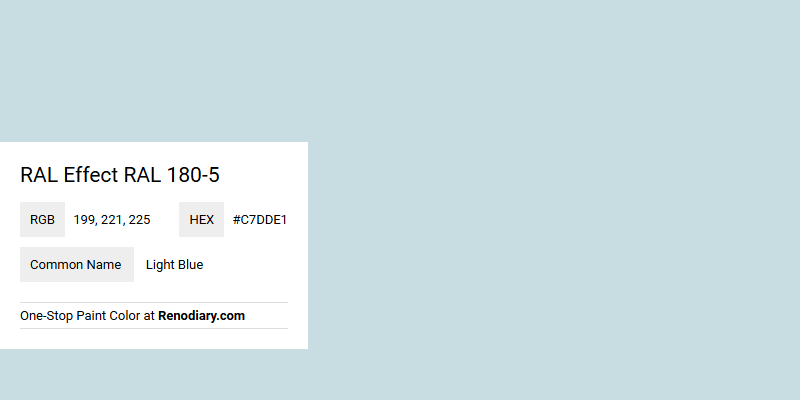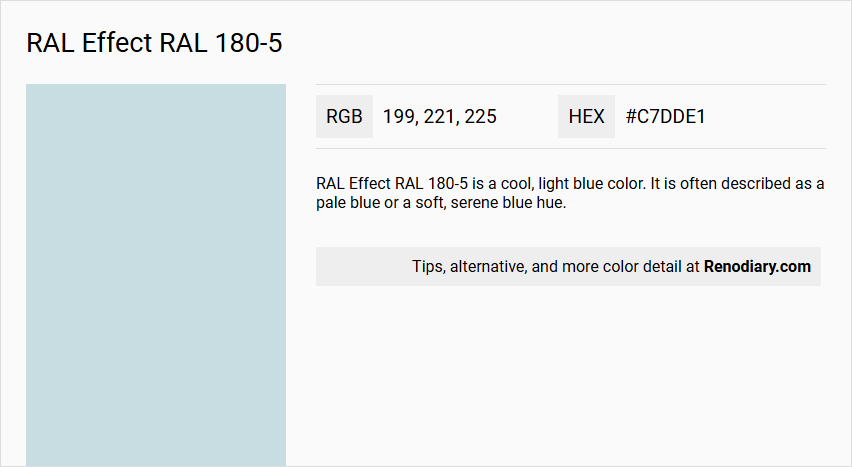
RAL Effect RAL 180-5, known for its soothing hue, is referred to as Light Blue and is harmoniously represented in the RGB color model with values (199, 221, 225). This shade embodies tranquility and calmness, making it ideal for settings looking to create a serene atmosphere. Its subtle blend of softness and clarity can gracefully complement a wide range of color palettes in both digital and physical spaces.
Color Description
RAL Effect RAL 180-5 is a cool, light blue color. It is often described as a pale blue or a soft, serene blue hue.
Undertones
The undertone of RAL 180-5 can be accurately described as a blue hue. This blue undertone is evident when isolating the pure hue from any tints, tones, and shades.
Color Values
- HEX: #C7DDE1
- RGB: 199, 221, 225
- CMYK: While not explicitly provided in the sources, the CMYK values for similar shades can be approximated. For precise values, refer to the RAL color charts.
- HSL: The HSL values are approximately 193°, 12%, 90% for a similar shade, though the exact HSL for #C7DDE1 may vary slightly.
Usage
RAL 180-5 can be used in various design and decorative contexts, including:
- Interior design: Suitable for living room walls, trims, kitchen cabinets, bedroom accent walls, and bathroom decor.
- Exterior design: Can be used for house exteriors to create a calm and serene appearance.
- It is also versatile enough to be used on furniture, storage solutions, and other decorative elements.
Atmosphere
The color RAL 180-5 creates a calm, serene, and cool atmosphere. It is soothing and can add a sense of tranquility to any space where it is used. The light blue hue makes it ideal for creating a peaceful and relaxing environment.
RAL Effect RAL 180-5 Color Alternative
The color alternative for RAL Effect RAL 180-5 provides designers with exciting options to achieve a unique aesthetic in their projects. Tikkurila G436, Tikkurila G358, and Dulux Mineral Mist 01BB 69/098 all offer distinct qualities that help in replicating the visual impact of the original while allowing for creative flexibility. By incorporating these alternatives, professionals can maintain the intended atmosphere of their work while exploring innovative variations in color application.
Bathroom
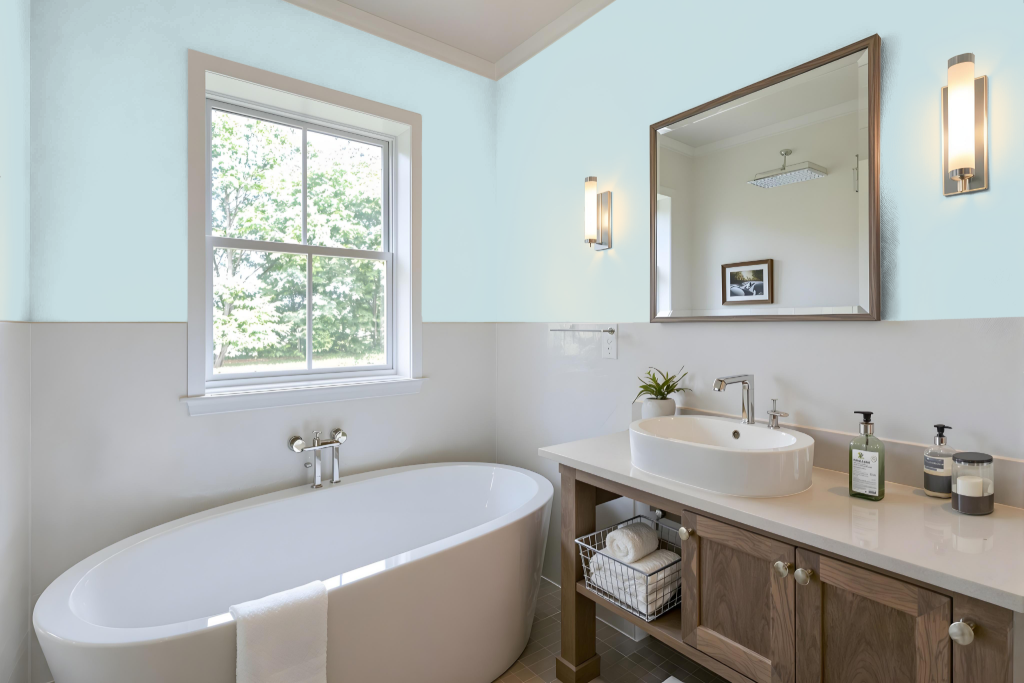
For a bathroom, RAL Effect RAL 180-5 creates a calming and refreshing ambiance with its balanced tone. Its light-reflecting properties help brighten the space and enhance the perception of roominess, making it an excellent choice for walls, trims, and cabinetry.
To achieve the most accurate representation, it is advised to refer to a physical color sample during application. This ensures the final result remains true to the intended serene atmosphere for your bathroom setting.
Bedroom

For a bedroom color scheme, RAL Effect RAL 180-5 creates a calming, serene atmosphere perfect for spaces dedicated to rest and relaxation. This hue sets a tranquil tone that can be used for accent walls, bedding, or furniture, establishing a cohesive environment that encourages comfort and peace.
Paired with complementary hues such as deeper blue or green shades to add depth, or neutral tones like beige or white to maintain a light and airy feel, RAL Effect RAL 180-5 enhances the overall aesthetic. Its ability to blend with other colors cultivates a well-balanced and soothing setting that invites relaxation while preserving visual interest.
Kitchen
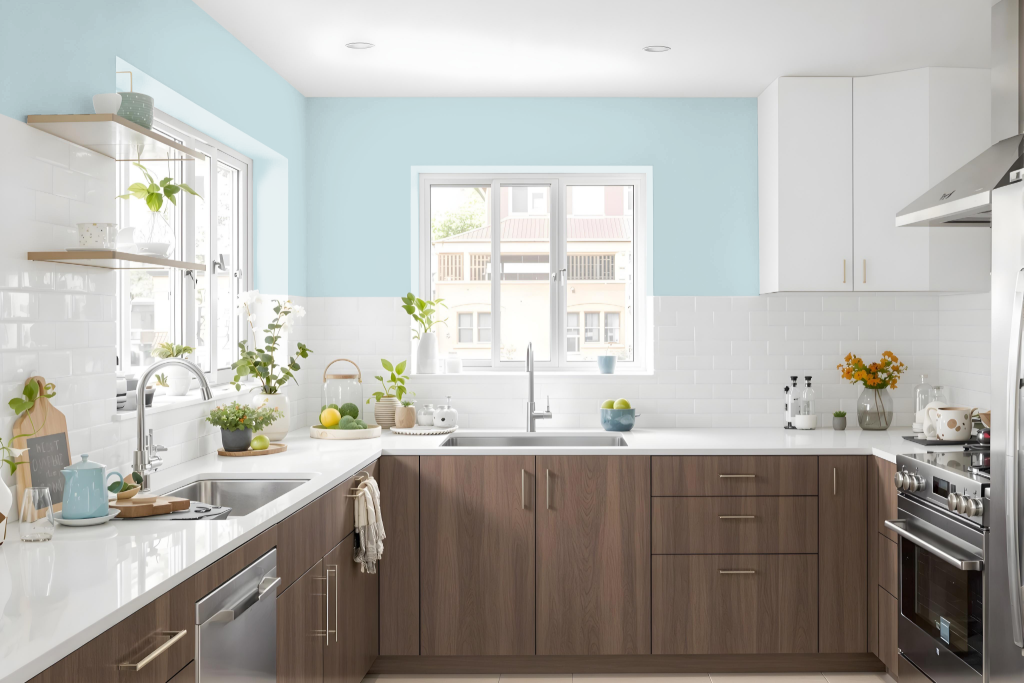
For a kitchen color scheme, RAL Effect RAL 180-5 offers a refreshing and balanced aesthetic, harmonizing beautifully with backsplashes, countertops, and hardware. Paired with lighter accents such as white or light-gray elements, it contributes a modern, clean look while still accommodating darker touches for depth.
Integrating warmer hues through flooring or furniture adds a cozy feel to the space. Additionally, its high light reflectance quality ensures the kitchen appears brighter and more spacious, creating an inviting environment for everyday use.
Living Room
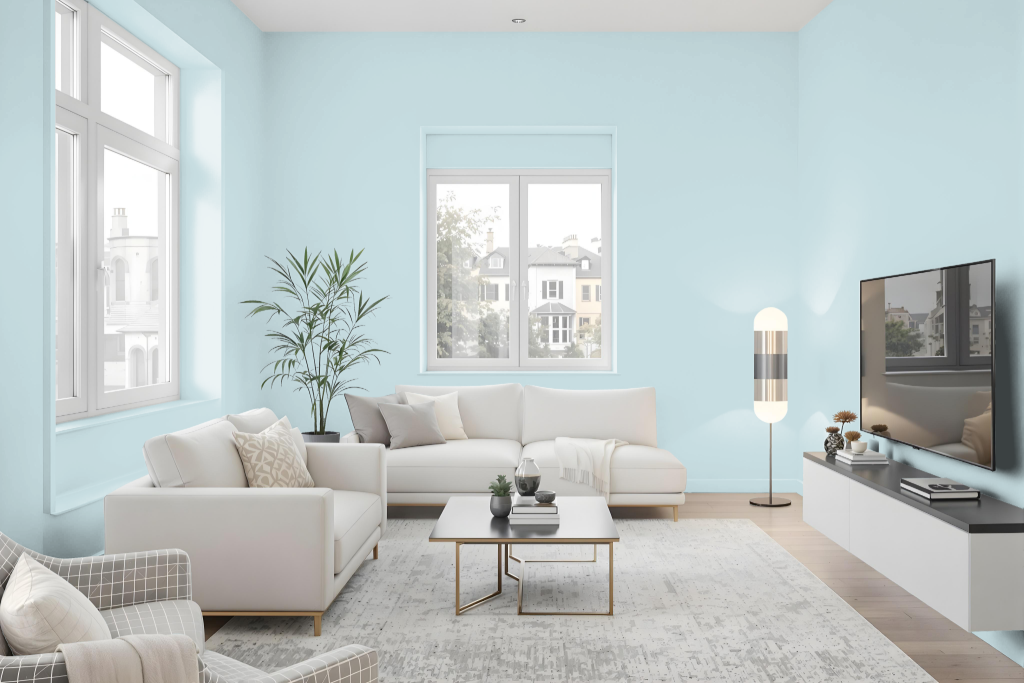
The living room color RAL Effect RAL 180-5 creates a calm atmosphere, making spaces feel larger and more airy. When applied on walls, it imparts a serene ambiance that enhances the overall brightness of the room, helping even areas with limited natural light feel inviting.
This shade harmonizes beautifully with a range of decor styles, from modern to traditional, and pairs well with neutral furniture and accents. Used on trim and select details, it adds a subtle yet elegant touch that complements warmer tones and rich wood finishes for a balanced, sophisticated look.
Outdoor

Home outdoor color RAL Effect RAL 180-5 presents an appealing option for exterior spaces, ideal for accentuating walls, trims, and other outdoor features. Its high light reflectance value helps maintain brightness and visual appeal under varying natural light conditions, ensuring that surfaces remain luminous even as the day progresses.
For the most accurate representation, relying on a physical RAL color fan is recommended, as digital displays can misrepresent its true hue. This attention to detail in color selection contributes to a consistent and attractive finish across all outdoor elements, harmonizing both design and functionality.
